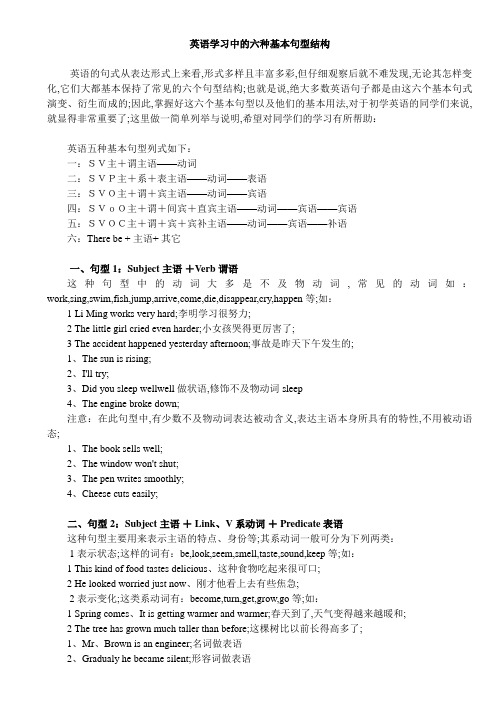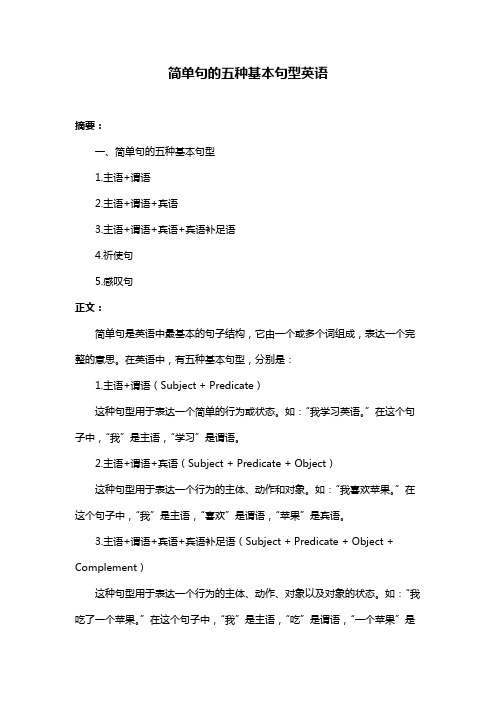高中英语简单句的六种基本句型
- 格式:ppt
- 大小:747.50 KB
- 文档页数:24

英语六种简单句型1.主语+系动词+表语(S+V+P)常见的系动词有be, look, sound,smell, taste, feel, become, turn, get等,表语通常是形容词、名词、代词等。
如:Your new watch looks very nice.你的新手表看起来很漂亮。
That sounds a good idea.听起来是个好主意。
2.主语+谓语(S+V)谓语是不及物动词,其后可加副词、介词短语等。
如:They sat together quietly.他们静静地坐在一起。
The meeting begins at nine.会议9点开始。
3.主语+谓语+宾语(S+V+O)谓语是及物动词,宾语通常是名词、代词、动词不定式、V-ing形式等。
如:He doesn’t like the movie.他不喜欢这部电影。
Do you know them, Li Ming?李明,你认识他们吗?4.主语+谓语+间接宾语+直接宾语(S+V+InO+DO)某些动词后的间接宾语可改为to引导的短语,如:give, lend, pass,show, send等;某些动词后的间接宾语可改为for引导的短语,如:buy, choose,cook, make, sing等。
如:Can you pass me the book?= Can you pass the book to me?你能把书递给我吗?She sang us an English song.= She sang an English song for us.她为我们唱了一首英语歌。
5.主语+谓语+宾语+宾语补足语(S+V+O+OC)这类谓语动词主要有find, keep,feel, wish, think, name, call, ask, advise, teach, want, notice等。
宾语补足语用来补充说明宾语的动作或状态,通常是形容词、名词、动词不定式、介词短语等。

六种简单句的基本句型2.“主语 + 谓语 + 宾语”(即“主谓宾”句型)这一句型英汉语言的.结构形式完全相同,用以说明“某人或某物做什么事情”,或者说“某人或某物发出了动作,并且其动作涉及到另一个人或物”。
例:I study English.分析:“I”(主语)“study”(谓语动作)“English”(宾语即动作涉及的对象)。
3.“主语 + 谓语 + 间接宾语 + 直接宾语”(即“主谓双宾”句型)这一句型英汉语序结构相同,说明“某人为谁(间接宾语为人)做某事”,或者说“某人或物的运动涉及到两个对象,其中一个间接对象为人,另一个为物”。
例:Our teacher taught us English.分析:“our teacher”(主语)“教”(谓语动作)“us”(间接宾语)“English”(直接宾语)。
4.“主语 + 谓语 + 宾语 + 宾语补足语”(即“主谓宾宾补”句型)这一句型说明“某人或某物要求(使、让)某人做什么”或“某人感觉某人或物怎么样”。
例: He asked her to go there.分析:“he”(主语)“asked”(谓语动作)“her”(宾语即动作涉及的对象)“to go there”(补语—补充说明宾语做什么)。
5.“主语 + 系动词+ 表语”(即“主系表”句型)这一句型用以说明“某人(某物、某事、某种概念)具有什么特征或处于什么状态”。
汉语的“是”字结构属于这一英语句型的形式之一。
常用的联系动词有be, keep,lie, remain, stand, become, fall, get, go, grow, turn, look, feel, seem, smell, sound, taste, 等。
例: I am a teacher. 我是一名老师分析:“I”(主语)“am”(系动词)“a teacher”(表语—即表明主语的身份)。


英语学习中的六种基本句型结构英语的句式从表达形式上来看,形式多样且丰富多彩,但仔细观察后就不难发现,无论其怎样变化,它们大都基本保持了常见的六个句型结构;也就是说,绝大多数英语句子都是由这六个基本句式演变、衍生而成的;因此,掌握好这六个基本句型以及他们的基本用法,对于初学英语的同学们来说,就显得非常重要了;这里做一简单列举与说明,希望对同学们的学习有所帮助:英语五种基本句型列式如下:一:SV主+谓主语——动词二:SVP主+系+表主语——动词——表语三:SVO主+谓+宾主语——动词——宾语四:SVoO主+谓+间宾+直宾主语——动词——宾语——宾语五:SVOC主+谓+宾+宾补主语——动词——宾语——补语六:There be + 主语+ 其它一、句型1:Subject 主语+Verb 谓语这种句型中的动词大多是不及物动词,常见的动词如:work,sing,swim,fish,jump,arrive,come,die,disappear,cry,happen等;如:1 Li Ming works very hard;李明学习很努力;2 The little girl cried even harder;小女孩哭得更厉害了;3 The accident happened yesterday afternoon;事故是昨天下午发生的;1、The sun is rising;2、I'll try;3、Did you sleep wellwell做状语,修饰不及物动词sleep4、The engine broke down;注意:在此句型中,有少数不及物动词表达被动含义,表达主语本身所具有的特性,不用被动语态;1、The book sells well;2、The window won't shut;3、The pen writes smoothly;4、Cheese cuts easily;二、句型2:Subject 主语+ Link、V系动词+ Predicate表语这种句型主要用来表示主语的特点、身份等;其系动词一般可分为下列两类:1表示状态;这样的词有:be,look,seem,smell,taste,sound,keep等;如:1 This kind of food tastes delicious、这种食物吃起来很可口;2 He looked worried just now、刚才他看上去有些焦急;2表示变化;这类系动词有:become,turn,get,grow,go等;如:1 Spring comes、It is getting warmer and warmer;春天到了,天气变得越来越暖和;2 The tree has grown much taller than before;这棵树比以前长得高多了;1、Mr、Brown is an engineer;名词做表语2、Gradualy he became silent;形容词做表语3、She remained standing for a hour;现在分词做表语4、The question remained unsolved;过去分词做表语5、The machine is out of order;介词短语做表语6、The television was on;副词做表语7、His plan is to keep the affair secret;动词不定式做表语8、My job is repairing cars;动名词做表语9、The question is what you want to do;从句做表语,即:表语从句注意:在下面的句子中,形容词做表语,在表语的后面常常接不定式结构;I'm happy to meet you;They are willing to help;We are determined to follow his example;三、句型3:Subject主语+ Verb 谓语+ Object 宾语这种句型中的动词一般为及物动词;其宾语通常由名词、代词、动词不定式、动名词或从句等来充当;例:1 He took his bag and left;名词他拿着书包离开了;2 Li Lei always helps me when I have difficulties;代词当我遇到困难时,李雷总能给我帮助;3 She plans to travel in the coming May Day;不定式她打算在即将到来的“五一”外出旅游;4 I don’t know what I should do next;从句我不知道下一步该干什么;1、Do you know these peoplethem名词或代词做宾语2、I can't express myself in English;反身代词做宾语3、He smiled a strange smile;同源宾语4、We can't afford to pay such a price;不定式做宾语5、Would you mind waiting a few minutes动名词做宾语6、I hope that I have said nothing to pain you;从句做宾语,即:宾语从句注意:并不是所有的及物动词都可以接上述各种情况做宾语,不同的动词有不同的用法,所以,在学习动词时,一定要掌握其用法;四、句型4: Subject主语+Verb谓语+Indirect object间接宾语+Direct object 直接宾语这种句型中,直接宾语为主要宾语,在句中不可或缺,常常由表示“物”的名词来充当;间接宾语也被称之为第二宾语,去掉之后,对整个句子的影响不大,多由指“人”的名词或代词承担;引导这类双宾语的常见动词有:buy,pass,lend,give,tell,teach,show,bring,send等;如:1 Her father bought her a dictionary as a birthday present;她爸爸给她买了一本词典作为生日礼物;2he old man always tells the children stories about the heroes in the Long March;老人经常给孩子们讲述长征途中那些英雄的故事;上述句子还可以表达为:1Her father bought a dictionary for her as a birthday present;2The old man always tells stories about the heroes to the children in the Long March;在此句型中,动词可以称作双宾语动词,在英语中,这样的动词并不多,在学习遇时,要牢记;后面的宾语为间接宾语和直接宾语,其中间接宾语在前,一般表人,直接宾语在后,一般表物;这类句型有三种情况;第一种情况,间接宾语可以改为to引导的短语;1、He handed me a letter;He handed a letter to me;2、She gave me her telephone number;She gave her telephone number to me;第二种情况,间接宾语可以改为for引导的短语;3、She sang us a folk song;She sang a folk for us;4、She cooked us a delicious meal;She cooked a delicious meal for us;第三种情况,直接宾语可以由宾语从句充当;5、Tell him I'm out;6、Can you inform me where Miss Green lives五、句型5:Subject主语+Verb 动词+Object 宾语+Complement补语这种句型中的“宾语+补语”统称为“复合宾语”;宾语补足语的主要作用或者是补充、说明宾语的特点、身份等;或者表示让宾语去完成的动作等;担任补语的常常是名词、形容词、副词、介词短语、分词、动词不定式等;如:1You should keep the room clean and tidy;你应该让屋子保持干净整洁;形容词2 We made him our monitor;名词我们选他当班长;3 His father told him not to play in the street;不定式他父亲告诉他不要在街上玩;●常见的动词有:tell,ask,advise,help,want,would like,order,force,allow等;●注意:动词have,make,let,see,hear,notice,feel,watch等后面所接的动词不定式作宾补时,不带to;如:1 The boss made him do the work all day;老板让他整天做那项工作;2 I heard her sing in the next room all the time last night;昨天晚上我听见她在隔壁唱了一个晚上;在此句型中的动词,叫做可以跟复合宾语的动词,在英语中,这样的动词也不多;后面的宾语补足语是说明宾语的情况的,宾语和宾语补足语一起被称做复合宾语;这个句式是英语中比较复杂的一个句式,因为复合宾语的构成内容较多;下面句子中划线部分为宾语补足语;1、He found his new job boring;形容词做宾补2、They called their daughter Mary;名词做宾补3、This placed her in a very difficult position;介词短语做宾补4、We went to her house but found her out;副词做宾补5、What do you advise me to do不定式做宾补6、We thought him to be an honest man;tobe做宾补7、He believed them to have discussed the problem;不定式的完成式做宾补8、He believed her to be telling the truth;不定式的进行式做宾补9、Did you notice him come in不带to的不定式做宾补10、I saw her chatting with Nancy;现在分词做宾补11、He watched the piano carried upstairs;过去分词做宾补注意:在这个结构中,可以出现用it做形式上的宾语,把真正的宾语放在宾语补足语的后面;在此结构中,宾语常常是动词不定式或宾语从句;1、He felt it his duty to mention this to her;分析:it是形式宾语,his duty是宾语补足语,to mention this to her是真正的宾语;2、I think it best that you should stay with us;分析:it是形式宾语,best是宾语补足语,that you should stay with us是真正的宾语;注意:习惯用语的使用在英语中,有很多动词习惯用语,在学习的过程中,要注意它们的使用,不必分析单独每个词的使用;例:We are short of money;be short of中short做表语She is always making trouble for her friends;trouble做make的宾语He has carried out our instructions to the letter;our instructions做词组carry out的宾语We are waiting for the rain to stop;wait for后面的the rain是宾语,to stop是宾语补足语2、在英语中,大多数动词既可以做及物动词又可以做不及物动词,而且还会有一些固定词组,因此一个动词可以用于几种句型;例:ask①Did you ask the price直接接名词做宾语②She asked them their names;接双宾语③I asked James to buy some bread;接宾语加不定式做宾语补足语④I asked to speak to Fred;接不定式做宾语⑤Didn't you ask him in在此句中和副词in连用⑥He has asked for an interview with the President;组成固定词组ask for3、There be句型是一种特殊的句子,真正的主语在后面,含义为“有…”①谓语动词和主语保持一致:There is a television in the sitting room;②有两个或更多的主语时,动词一般和最近的一个保持一致:There are two girls and a boy dancing in the hall;③主语的后面有时有修饰语:There are a lot of difficulties facing us;There were many things to be done此处也可以使用to do;④谓语动词be可以有时态的变化:There will be a concertin the park tonight;There was littlechange in him;⑤谓语也可以有不定式构成的复合谓语;There used to be a cinema here;There seems to be something the matter with her;Is there going to be any activity tonight⑥there be句式变疑问句,把be提前;变翻译疑问句也要借助there;Is there any hope of getting the jobThere is nothing wrong with your watch,is there⑦there be句型中也可以使用诸如:live,follow,come,stand,sit,exist等不及物动词:Once upon a time,there lived a fisherman on the island;There came a knock at the door;At the top of the hill there stands an old temple;⑧用于非谓语的情况下,有时用不定式的复合结构there to be或动名词的复合结构和独立主格结构there being:You wouldn't want there to be another war;不定式的复合结构The teacher was satisfied with there being no mistakes in his homework;动名词的复合结构There being nothing else to do,we went home;独立主格结构六、句型6:There be + 主语 + 其它这一结构表示“某地有某物”;主语一般位于there be 之后;值得关注的是,当句中有两个或更多的主语时,动词一般和最近的一个保持一致:1) There are two girls and a boy running on the playground;巩固性练习请判断下列句子的结构类型1、He is running;2、The loud voice from the upstairs made him angry;3、The little boy is asking the teacher all kinds of questions;4、She seemed angry;5、My father bought me a beautiful present;6、Why do you keep your eyes closed7、Will you tell us an exciting story8、We must keep our classroom tidy and clean;9、I heard the baby crying in the sitting room;10、Can you push the window open答案:1、主语---动词2、主语---动词---宾语---补语3、主语---动词---宾语---宾语4、主语---动词----表语5、主语---动词---宾语---宾语6、主语---动词---宾语---宾语7、主语---动词---宾语---补语8、主语---动词---宾语---补语9、主语---动词---宾语---补语10、主语---动词---宾语---补语。

简单句的五种基本句型英语
摘要:
一、简单句的五种基本句型
1.主语+谓语
2.主语+谓语+宾语
3.主语+谓语+宾语+宾语补足语
4.祈使句
5.感叹句
正文:
简单句是英语中最基本的句子结构,它由一个或多个词组成,表达一个完整的意思。
在英语中,有五种基本句型,分别是:
1.主语+谓语(Subject + Predicate)
这种句型用于表达一个简单的行为或状态。
如:“我学习英语。
”在这个句子中,“我”是主语,“学习”是谓语。
2.主语+谓语+宾语(Subject + Predicate + Object)
这种句型用于表达一个行为的主体、动作和对象。
如:“我喜欢苹果。
”在这个句子中,“我”是主语,“喜欢”是谓语,“苹果”是宾语。
3.主语+谓语+宾语+宾语补足语(Subject + Predicate + Object + Complement)
这种句型用于表达一个行为的主体、动作、对象以及对象的状态。
如:“我吃了一个苹果。
”在这个句子中,“我”是主语,“吃”是谓语,“一个苹果”是
宾语,“了”是宾语补足语。
4.祈使句(Imperative Sentence)
祈使句用于表达命令、请求、劝告等。
如:“请打开窗户。
”在这个句子中,没有主语,只有谓语“打开”。
5.感叹句(Exclamatory Sentence)
感叹句用于表达惊喜、惊讶、赞叹等强烈情感。
如:“多么美丽的景色!”在这个句子中,“多么”是感叹词,“美丽”的“景色”是主语和宾语。
以上就是英语简单句的五种基本句型。

简单句的六种基本句型及其主要用法。
一、S + V(主语+不及物动词)这种句型简称为主谓结构。
不及物动词是指那些本身意义已完整,后面不需要接宾语的动词,如come, go, swim, appear, run, arrive, fall等。
如:—Did you go by sea?你们走的是海路吗?—No, we flew. 不,我们是坐飞机去的。
有时,不及物动词后面会跟副词、介词短语等作状语。
如:Why don’t you come at once when I call you? 我叫你时,你为什么不马上来?【练习导航】Ⅰ. 根据汉语完成下列英语句子,每空一词。
1. 他在听。
He _____ _____.2. 昨晚你睡得好吗?Did you _____ _____ last night?3. 这场雨持续了两个小时。
The rain _____ _____ two hours.4. 事物总是变化的。
Things always _____.5. 他来中国的梦想实现了。
His dream to China _____ _____ _____.Ⅱ. 单项选择( )6. An MP5 player of this type costs too much. You’d better ______.A. waitB. waitingC. waitedD. to wait( )7. It _____ outside. I have to stay at home.A. rainB. is rainingC. rainedD. has rained( )8. —Did you watch the basketball match yesterday?—Yes, I did. My uncle ______ in the match.A. is playingB. was playingC. has playedD. will play( )9. —What did your father say just now?—Sorry, I don’t know. I ______ on the phone.A. am talkingB. talkC. was talkingD. have talked( )10. You ______ first and I ______ behind.A. go; was followingB. will go; followC. will go; followedD. go; will follow二、S + V + P(主语+系动词+表语)系动词通常与表语一起构成系表结构,用来说明主语的性质、特点或状态等。
英语中简单句的五种句型
英语中简单句的五种句型分别是:主语+谓语、主语+谓语+宾语、主语+谓语+表语、主语+谓语+宾语+宾补和主语+谓语+宾语+状语。
以下是这五种句型的详细介绍:
1.主语+谓语:这种句型中的谓语动词是不及物动词,即动词后面不需
要宾语,直接表达动作或状态。
例如:“He smiled. 他笑了。
”2.主语+谓语+宾语:这种句型中的谓语动词是及物动词,即动词后面需
要宾语来表达动作或状态。
例如:“He likes music. 他喜欢音乐。
”
3.主语+谓语+表语:这种句型中的谓语动词是系动词,如“be”、
“seem”、“look”等,后面连接的是表语,通常描述主语的性质或状态。
例如:“He is a teacher. 他是一名老师。
”
4.主语+谓语+宾语+宾补:这种句型中的谓语动词后需要一个宾语和一
个宾补来共同表达完整的动作或状态。
例如:“They elected him president. 他们选举他为总统。
”其中,“president”是宾补,补充说明“他”的身份。
5.主语+谓语+宾语+状语:这种句型中的谓语动词后需要一个宾语和一
个状语来共同表达完整的动作或状态。
例如:“She sings
beautifully. 她唱得很美。
”其中,“beautifully”是状语,修饰“唱”这个动作。
以上就是英语中简单句的五种句型。
Module 6 HobbiesUnit 3 Language in use姓名:班级:学习目标:1.复习本模块的单词及短语。
2.总结和练习简单句的使用。
3.能运用所学有关爱好的知识,写一篇与爱好有关的文章。
学习重点:总结和练习简单句的使用。
学习难点:能运用所学有关爱好的知识,写一篇与爱好有关的文章。
一、简单句的六种基本句型。
只有一个主语或并列主语和一个谓语或并列谓语的句子叫简单句。
例如:We learn English. 我们学英语。
Both my father and my mother go to work at seven in the morning and come back home at six in the evening.我父母都是早上七点上班,晚上六点回到家。
简单句分为六种基本句型:①主语+系动词+表语(s+v+p)常见的系动词有be, look, seem, smell, taste, sound, become, get, grow, turn 等。
例如:My father is a teacher. 我爸爸是老师。
She always looks happy.她看上去总是很快乐。
②主语+不及物动词(s+v)不及物动词后不能跟宾语,但可跟必要的状语修饰。
例如:The new term usually begins in September.新学年通常从九月份开始。
We work hard at English.我们努力学习英语。
③主语+及物动词+宾语(s+v+o)及物动词后必须跟宾语。
例如:He enjoys music very much.他非常喜爱音乐。
I collected stamps last year.去年我集邮了。
④主语+及物动词+间接宾语+直接宾语(S+V+IO+DO)有的动词后有个宾语,表示人的间接宾语和表示物的直接宾语。
这类动词常见的有bring, give, hand, pass, sell, show和buy, choose, draw, cook, make, order, sing等。
英语简单句的六种基本句型(学生)基本句型汉译英练习一、主谓结构说明:本结构是由主语+谓语动词构成(其中的谓语动词须是不及物的动词vi),用来表示主语的动作。
如: The sun rises.主语可有修饰语---定语,如,The red sun rises谓语可有修饰语---状语,如,The red sun rises in the east.主语可以用充当。
翻译练习1.你应当努力学习。
You should study hard.2.她昨天回家很晚。
She went home very late yesterday evening.3.那天早上我们谈了很多。
That morning we talked a great deal.4.会议将持续两个小时。
The meeting will last two hours.5.在过去的十年里,我的家乡已经发生了巨大的变化。
Great changes have taken place in my home town in the past ten years.6.这种事情全世界各地每天都在发生。
7.1919年,在北京爆发了“五.四”运动。
8.每天八时开始上课。
9.这个盒子重五公斤。
10.五年前我住在北京。
11.爱丽丝很会游泳。
12.约翰的父亲昨晚去世了。
13.秋天有些鸟飞到南方去。
14.我的爷爷早晨起得很早。
15.每天下午有许多学生到图书馆来借书。
二、主系表结构说明:本结构是由主语+系动词+表语组成,主要用以说明主语的特征,类属,状态,身份等。
系动词有:(1)表示特征和存在状态的 be, seem, feel, appear, look, smell, taste, sound.(2)表示状态延续的 remain, stay, keep, continue, stand.(3)表示状态变化的 become, get, turn, go, run, fall, come, grow.翻译练习:1.我的兄弟都是大学生。